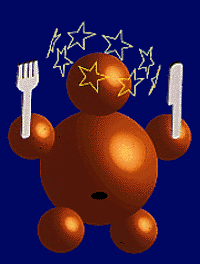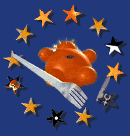Welcome to
Nik's World of Dairy Produce!
Brought to you by The Cheesemaster
Yes, here at Nik's World of Dairy Produce we take our foodstuffs very
seriously. To you we offer the ultimate in delectability: a presentation of food
mostly derived from the milk of farmyard animals! As long as there have been dairy
farms there has been dairy produce. Eggs are the most self
contained of the dairy foods discussed here, coming generally in only one basic
model, with differing trim. Milk is the root of the other
foods, being as it is the base of cheese, yoghurt
and cream. Cream is not really important enough to merit a separate entry, although
it does come into it's own with whisky and sugar and cofee in Bailey's Irish Cream.
To begin, we will choose the basic and final form of dairy produce, the egg.
Eggs
This is the ovo part of an ovo-lacto vegetarian's diet. It is distinguished
from all the other foods mentioned here because it comes from birds, as
opposed to mammals. Although small and self contained, eggs are surprisingly
versatile; made up of yolk (the nutritive part) and albumen (the gross
part) and of course a hard protective shell, there are many ways of utilising
these tasty parts. As a warning, I offer my past experience, that no egg
dishes cook well in the microwave.
Recipes

-
The Classic Boiled egg
-
This is probably he easiest egg dish to make, and often is just what's
needed to stop that gap in your stomach. It's really quite simple. Boil
some water in a kettle. This is always faster than doing it on the stove.
You need as much as will cover the eggs in a saucepan. Put the pan on the
stove, turn up the heat, pour the boiled water into the pan, and lower
the eggs in. Go away. Return in a few minutes, remove eggs and eat, having
removed shell first. If you want the yolk runny, wait about 5 minutes before
returning. If you want it hard, wait about 13 minutes. If you want it green,
wait about 20 minutes. Soft-boiled eggs are great with salt and toast,
whereas hard boiled are lovely with mayonnaise, a touch of pepper and sticks
of carrot.
- The Fried Egg

-
This is also a very simple dish, but can be executed in a variety of
ways. Americans have loads of names for fried eggs (I suppose to liven
their lives in the dull early colonial days) like "over easy" and whatever,
but in reality their are only two ways to succesfully fry an egg.
-
Heat frying pan with oil of some kind. I prefer to keep it in the family
and use butter, from a cow.
-
When this is very hot, break the shell of the uncooked egg and let the
egg flow from the shell into the pan. It is generally accepted that it
is best for the yolk to remain intact as it enters the fat. from now on
there are two approaches.
-
You can cook the egg without turning it - some people like to put a
lid on the and poach the egg from above.
-
You can turn the egg, just before the end of the cooking, to ensure
all the white is cooked. This is risky because often the yolk breaks and
this is to be avoided.
Serve on toast (buttered, of course) or with meat or chips or whatever
you like. If the yolk breaks, you can always revert to:

-
Scrambled eggs
-
Same as fried eggs but all broken up and with milk. Swish it around
in the pan a bit until it's cooked. I like it with salt and pepper and
possibly Dijon mustard.
-
Souffle
-
Simple. Heat up oven a lot, and make a cheese sauce. Use Knorr packet
cheese sauce. Chuck in a few egg yolks - about six usually does it. Aggressively
beat up the whites until they are stiff (muscle damage?) and fold the whites
into the sauce, or vice-versa, and then put in souffle dish (a squat cylinder)
and then into the oven. Half an hour later eat it, having removed it from
the oven. Things to put into the souffle:
-
Mustard
-
Tuna
-
Stilton
-
Ham
-
Spicy things
Thank you for calling in on Nik's World of Dairy Produce


